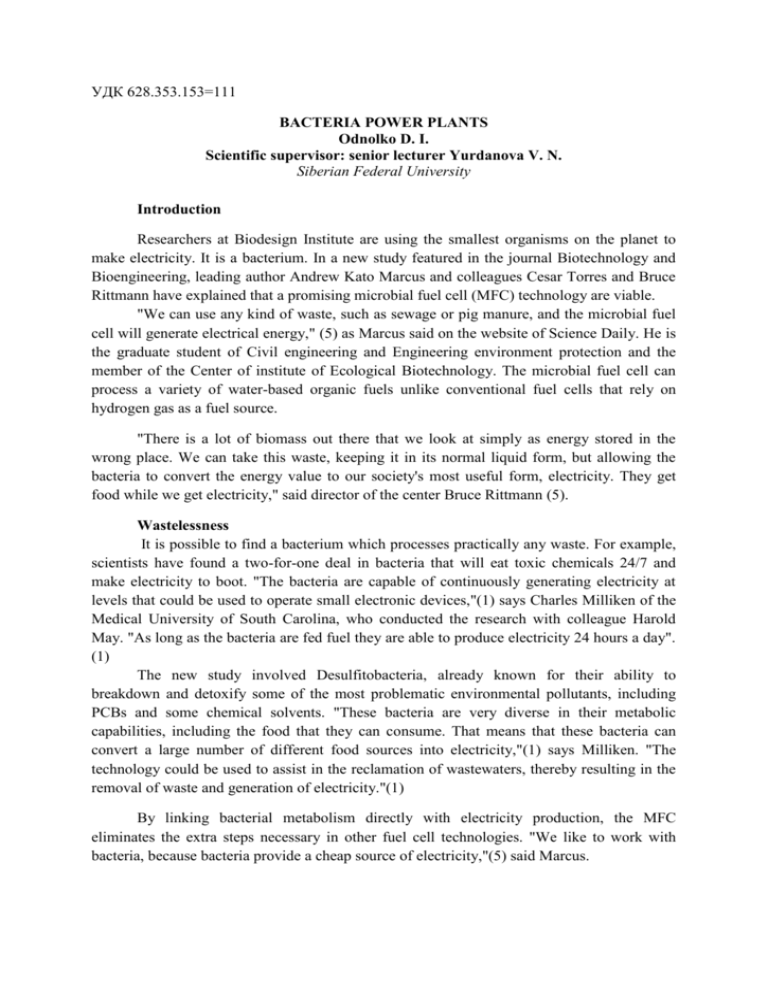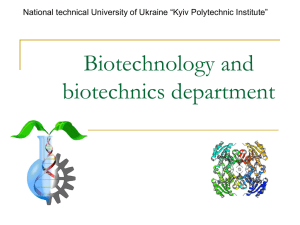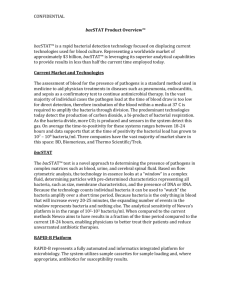УДК 628.353.153=111 BACTERIA POWER PLANTS Odnolko D. I.
advertisement

УДК 628.353.153=111 BACTERIA POWER PLANTS Odnolko D. I. Scientific supervisor: senior lecturer Yurdanova V. N. Siberian Federal University Introduction Researchers at Biodesign Institute are using the smallest organisms on the planet to make electricity. It is a bacterium. In a new study featured in the journal Biotechnology and Bioengineering, leading author Andrew Kato Marcus and colleagues Cesar Torres and Bruce Rittmann have explained that a promising microbial fuel cell (MFC) technology are viable. "We can use any kind of waste, such as sewage or pig manure, and the microbial fuel cell will generate electrical energy," (5) as Marcus said on the website of Science Daily. He is the graduate student of Civil engineering and Engineering environment protection and the member of the Center of institute of Ecological Biotechnology. The microbial fuel cell can process a variety of water-based organic fuels unlike conventional fuel cells that rely on hydrogen gas as a fuel source. "There is a lot of biomass out there that we look at simply as energy stored in the wrong place. We can take this waste, keeping it in its normal liquid form, but allowing the bacteria to convert the energy value to our society's most useful form, electricity. They get food while we get electricity," said director of the center Bruce Rittmann (5). Wastelessness It is possible to find a bacterium which processes practically any waste. For example, scientists have found a two-for-one deal in bacteria that will eat toxic chemicals 24/7 and make electricity to boot. "The bacteria are capable of continuously generating electricity at levels that could be used to operate small electronic devices,"(1) says Charles Milliken of the Medical University of South Carolina, who conducted the research with colleague Harold May. "As long as the bacteria are fed fuel they are able to produce electricity 24 hours a day". (1) The new study involved Desulfitobacteria, already known for their ability to breakdown and detoxify some of the most problematic environmental pollutants, including PCBs and some chemical solvents. "These bacteria are very diverse in their metabolic capabilities, including the food that they can consume. That means that these bacteria can convert a large number of different food sources into electricity,"(1) says Milliken. "The technology could be used to assist in the reclamation of wastewaters, thereby resulting in the removal of waste and generation of electricity."(1) By linking bacterial metabolism directly with electricity production, the MFC eliminates the extra steps necessary in other fuel cell technologies. "We like to work with bacteria, because bacteria provide a cheap source of electricity,"(5) said Marcus. There are many types of MFC reactors, but all reactors have the same operating principles. All MFCs have are composed of a pair of battery-like terminals (an anode and cathode electrodes). The electrodes are connected by an external circuit and an electrolyte solution to help conduct electricity. The difference in voltage between the anode and cathode, along with the electron flow in the circuit, generate electrical power. In the first step of the MFC, an anode respiring bacterium breaks down the organic waste to carbon dioxide and transfers the electrons to the anode. Next, the electrons generate electrical energy to travel from the anode through an external circuit. Finally, the electrons are taken up by oxygen and hydrogen ions to form water on the cathode. Clean electricity British scientists have made an important breakthrough in the quest to generate clean electricity from bacteria. Findings published today show that proteins on the surface of the bacteria can produce an electric current by simply touching a mineral surface. The study has therefore found for the first time that it is possible for bacteria to lie directly on the surface of a metal or mineral and transfer electrical charge through their cell membranes. This means that it is possible to carry bacteria directly to electrodes - creating an efficient microbial fuel cells or bio-batteries. Researchers from the University of East Anglia are working with marine bacteria called «Shewanella oneidensis» (5). They knew that bacteria could transfer electricity into metals and minerals, and that the interaction depends on special proteins on the surface of the bacteria. But it was not been clear whether these proteins do this directly or indirectly through an unknown mediator in the environment."(6) The research showed that these proteins can directly touch the mineral surface, produce an electric current, and conduct electricity through their cell membranes. This was the first time that they actually saw how the components of a bacterial cell membrane were able to interact with different substances, and understood how differences in metal and mineral interactions could occur on the surface of a cell.(6) Production of electricity through the use of wastewater Researchers from the University of Pennsylvania (Pennsylvania State University) have created a prototype toilet working as a power station, which produces electricity due to the decomposition of organic waste. Started up in the case where bacteria, which are conventional in the wastewater. These bacteria feed on organic matter, releasing carbon dioxide. When this chemical reaction occurs in the transfer of electrons between atoms. Scientists have managed to break into the process and make these electrons escape to bypass - through an external circuit. When the tube was pumped through the impurity in the chain between the central and peripheral rods current goes. However, capacity is only a few milliwatts. But Bruce Logan (Bruce Logan), one of the sponsors, said that the team is working to increase capacity. (4) Perhaps, toilets, power plants will be able one or two bulbs, saving energy. In addition, the widespread introduction of new items would contribute to the further purification of wastewater. The importance of electrical potential is well known in a traditional fuel cell, but its relevance to bacterial metabolism was less clear. Bacteria will grow as long as there is an abundant supply of nutrients. Jacques Monod is one of the founding fathers of molecular biology. He developed an equation for bacteria bathed in a rich nutrient broth, but the challenge was to apply the Monod equation to the anode, a solid. Previously it was believed that the rate of bacterial metabolism at the anode increases when the electrical potential of the anode increases. The researchers could now think of the electrical potential as fulfilling the same role as a bacterial nutrient broth. It appeared that the electrical potential was proportional to the concentration of electrons which transition from bacteria to the anode. The researchers developed a new model, the Nernst-Monod (5) equation, to describe the rate of bacterial metabolism taking into account the "concentration of electrons" and the electrical potential. Promise meeting potential The team identified: the amount of waste material (fuel), the accumulation of biomass on the anode, and the electrical potential in the biofilm anode. The last factor was absolutely new term in MFC research. Modeling the potential in the biofilm anode it was predicted how much voltage they got and how to maximize the power output by tweaking the various factors. Thickness was one of the factors. Biofilm produced more current when the biofilm thickness was not too thick or thin. The innovative model is used to optimize performance and power output. The bacteria perform their useful tasks while in spore form, a dormant stage of growth that can handle extreme heat, radiation and lack of water -- all useful traits for an organism that might be employed in some of the worst manmade environments. Conclusion The bacteria perform their useful tasks while in spore form, a dormant stage of growth that can handle extreme heat, radiation and lack of water -- all useful traits for an organism that might be employed in some of the worst manmade environments. Literature: 1. Anode Biofilm Michal Schechter, Alex Schechter, Shmuel Rozenfeld, Emanuel Efrat and Rivka Cahan, http://defence.pk/threads/bacteria-to-generate-electricity.62630/ 2. http://news.grimuar.info/бактерии-помогут-вырабатывать-электричество-в-домашнихусловиях-372.html 4. http://subscribe.ru/archive/tech.electrotech/200810/21130324.html 5. Arizona State University. "Fuel Cell That Uses Bacteria To Generate Electricity." ScienceDaily. ScienceDaily, 7 January 2008, www.sciencedaily.com/releases/2008/01/080103101137.htm . 6. http://www.penmai.com/forums/science/48438-bacteria-could-generate-cleanelectricity.html 7. http://www.livescience.com/3835-double-bonus-bacteria-eat-pollution-generateelectricity.html









